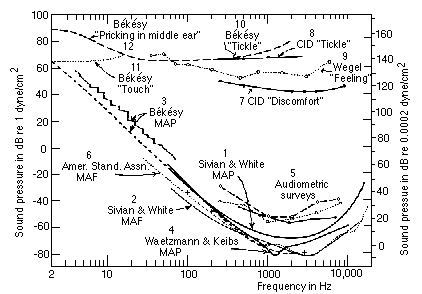|
|
The INTENSITY LEVEL where a sound becomes just audible. For a continuous tone of between 2000 and 4000 Hertz, heard by a person with good hearing acuity under laboratory conditions, this is 0.0002 dyne/cm2 SOUND PRESSURE and is given the reference level of 0 dB.
In terms of AMPLITUDE, the EARDRUM moves about 0.000000001 cm, much less than the wavelength of light. If the ear were any more sensitive it would detect the random movements of air molecules. While 0 dB is the reference employed, the threshold of hearing varies considerably with lower and higher frequencies (see graph of EQUAL LOUDNESS CONTOURS or PHON). Also called minimum audible field (MAF).
See: AUDIOGRAM, BONE CONDUCTION HEARING LEVEL, DECIBEL, DYNAMIC RANGE, HEARING LEVEL, MASKING, SOUND INTENSITY, SOUND PRESSURE LEVEL, THRESHOLD SHIFT. Compare: THRESHOLD OF PAIN, VU METER, ZERO LEVEL VU.
Alternate units for this reference level are: 2 x 10-4 microbar (µbar); 2 x 10-5 Newton/m2 (N/m2); 2 x 10-5 Pascal (Pa); 20 micropascal (µPa).

Determination of the threshold of audibility and the threshold of feeling. Curves 1 to 6 represent attempts to determine the absolute threshold of hearing at various frequencies by the authors listed. MAP = minimum audible pressure at the eardrum; MAF = minimum audible pressure in a free sound field, measured at the place where the listener's head had been. Curves 7 to 12 represent attempts to determine the upper boundary of the auditory realm, beyond which sounds are too intense for comfort, and give rise to nonauditory sensations of tickle and pain. From: Licklider, Handbook of Experimental Psychology, S.S. Stevens, ed., 1951, p. 995, used by permission.
home